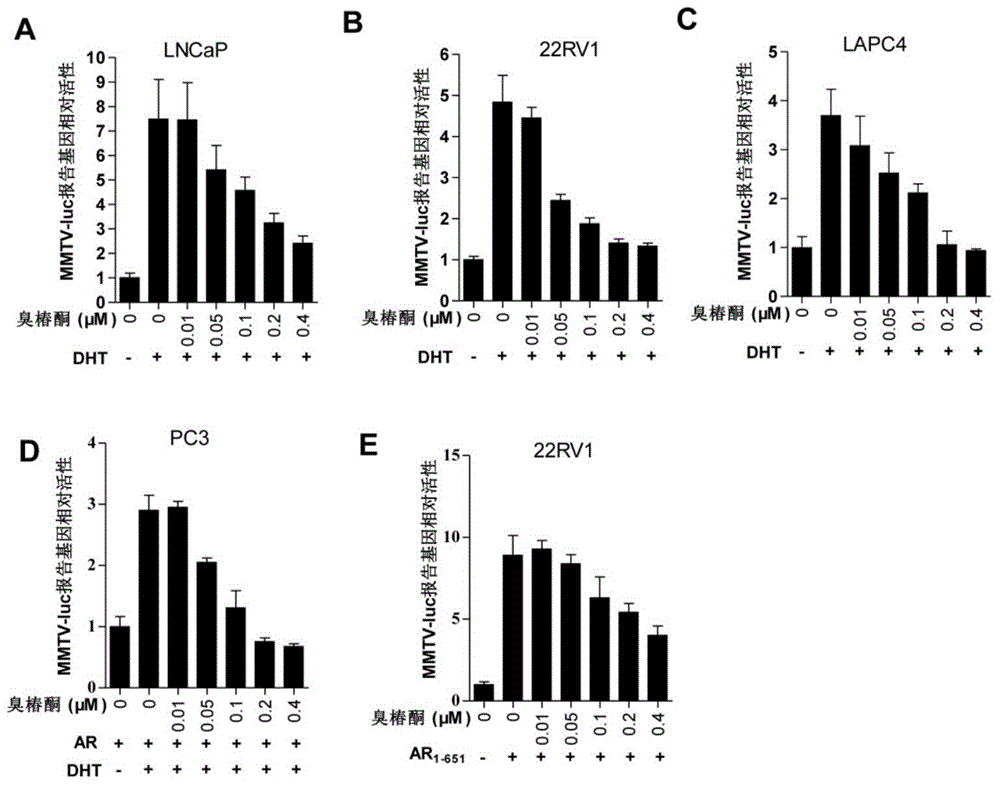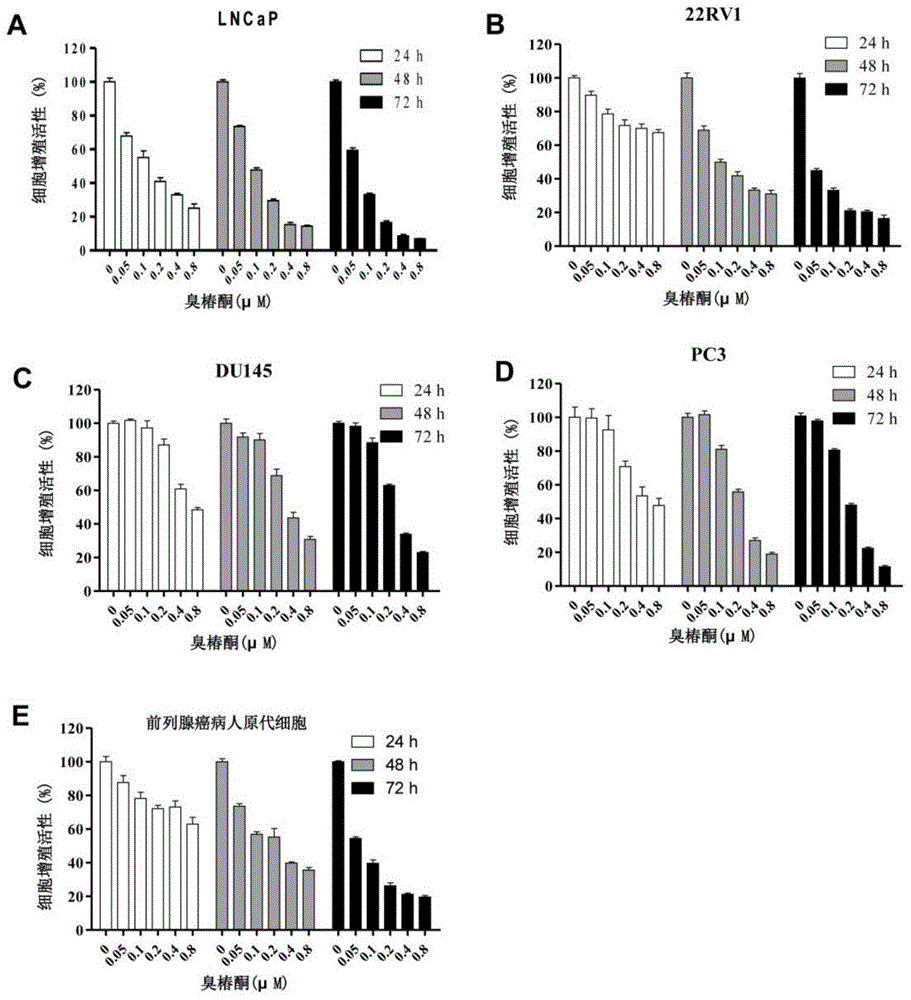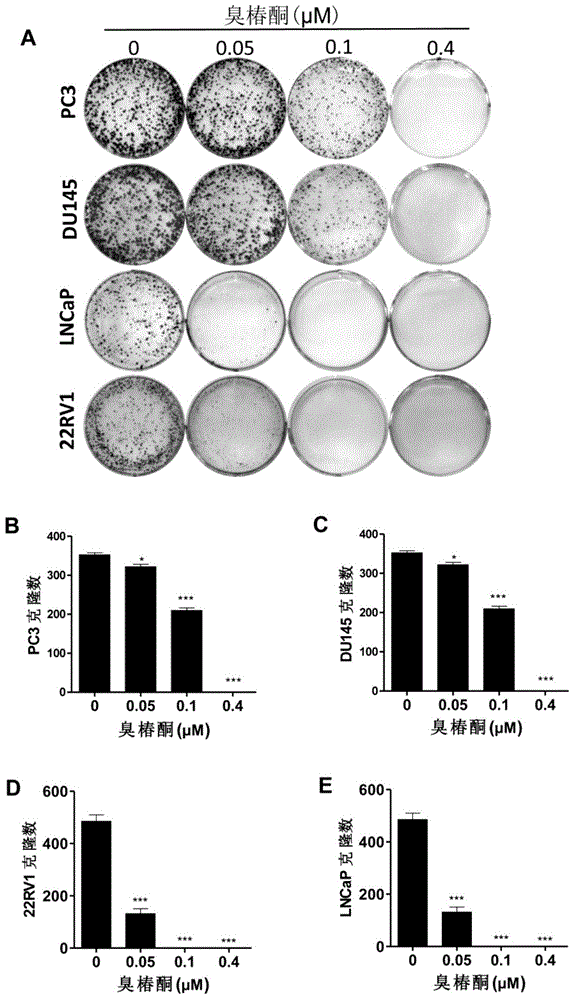Application of ailanthone to preparation of medicines for treating prostatic disease
A technology of Ailanthus ketone and prostate, applied in the field of medicine
- Summary
- Abstract
- Description
- Claims
- Application Information
AI Technical Summary
Problems solved by technology
Method used
Image
Examples
Embodiment 1
[0078] Embodiment 1: Formula (I) Ailanthione inhibits the transcriptional activity of androgen receptor in vitro
[0079] Technical method:
[0080] 1. Cell Culture
[0081] The cells used in this experiment were purchased from the Shanghai Cell Bank of the Chinese Academy of Sciences. Some cells came from the laboratory of Professor Weng Jiemin, Shanghai Key Laboratory of Regulatory Biology; another cell line came from the Changhai Hospital affiliated to the Second Military Medical University. The isolated prostate cancer cells were cultured in a constant temperature incubator at 37°C (humidity 95%, CO 2 concentration 5%), the medium was RPMI-1640 (6ibco) containing 10% fetal bovine serum (Front).
[0082] 2. Dual luciferase reporter gene detection
[0083] The plasmids used in this experiment are MMTV-LUC (nuclear hormone receptor reporter gene) and Renila (internal control reporter gene). MMTV-LUC is a reporter gene plasmid with androgen receptor transcription activatio...
Embodiment 2
[0085] Embodiment 2: formula (I) Ailanthus ketone inhibits the proliferative activity and clone formation of different prostate cancer cells
[0086] Technical method:
[0087] 1. SRB (sulfonyl rhodamine) assay for cell proliferation
[0088] Different prostate cell lines in 5×10 3 Cells / well were inoculated into 96-well plates (Corning). After 24 hours, different concentrations of the monomeric compound were added, and the same amount of DMSO was added to the control group. Six replicate wells were set up in each group. After continuing to culture for 24h, 48h and 72h respectively, add pre-cooled TCA (trichloroacetic acid, 50%, w / V) and incubate at 4°C for more than 60min to fix the cells. After fixing, rinse with running water 5 times and air dry. Add 50 μl of SRB staining solution (4%, w / V) to each well and incubate at room temperature for 10 minutes for staining. Aspirate the dye solution, add 100 μl of 1% acetic acid to each well and wash 5 times to remove unbound dye...
Embodiment 3
[0097] Embodiment 3: the inhibitory effect of formula (I) ailanthione monomer on the migration ability of prostate cancer cells
[0098] Technical method:
[0099] 1. Streak Migration Experiment
[0100] In order to study whether formula (I) Ailanthus ketone inhibits the lateral migration of cells, cells are inoculated to 6-well plates, and tumor cells are incubated at 37° C. in 5% CO 2 Routine culture in the incubator for 24 hours until the cells grow to 100% full. The serum-free medium was replaced, and the culture was continued for 12 h. In the culture wells full of cells, scratch with a 200 μl sterilized tip (tip), wash the cells twice with PBS after scratching, wash away the floating cells, and add 1 ml of complete medium to each well. Add different concentrations of drugs to the cell culture wells respectively, and place the culture plate in CO 2 Incubator, 37 ℃ for 24 hours to continue routine cultivation. Observe the movement of the cells to the lined part under a...
PUM
| Property | Measurement | Unit |
|---|---|---|
| Half inhibitory concentration | aaaaa | aaaaa |
| Molecular weight | aaaaa | aaaaa |
Abstract
Description
Claims
Application Information
 Login to View More
Login to View More - R&D
- Intellectual Property
- Life Sciences
- Materials
- Tech Scout
- Unparalleled Data Quality
- Higher Quality Content
- 60% Fewer Hallucinations
Browse by: Latest US Patents, China's latest patents, Technical Efficacy Thesaurus, Application Domain, Technology Topic, Popular Technical Reports.
© 2025 PatSnap. All rights reserved.Legal|Privacy policy|Modern Slavery Act Transparency Statement|Sitemap|About US| Contact US: help@patsnap.com



